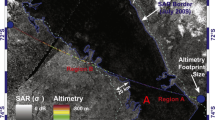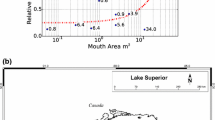Summary
The structures and periods of the lowest four normal modes of Lake Constance and the fundamental mode of the Bay of Konstanz are determined by an application of a simplified version of the two-dimensional theory developed by Rao and Schwab [12]. The effect of the earth's rotation is neglected, because the medium size of the Lake implies only a minor influence on the oscillations. The calculations of the lowest four modes are verified by spectral analyses of simultaneous measurements of water level fluctuations at up to 9 stations on the shore. In particular, the water wonder at Konstanz in 1549 described by Schulthaiss [14] is explained in terms of a possible resonant excitation of the fundamental mode of the Bay of Konstanz. For the analysis of this event a translation of Schulthaiss' notes, which give the oldest known observations on seiches, is included in the text together with some historical comments.
Zusammenfassung
Die Struktur und Perioden der vier niedrigsten Eigenschwingungen des Bodensees und die Grundschwingung der Bucht von Konstanz wurden durch Anwendung einer vereinfachten Version der von Rao und Schwab [12] entwickelten zweidimensionalen Theorie bestimmt. Der Effekt der Erdrotation wurde vernachlässigt, da der Einfluß auf die freien Schwingungen des Sees durch die mittlere Größe des Seebeckens gering ist. Die Berechnungen der niedrigsten vier Eigenschwingungen werden durch Spektralanalysen von gleichzeitigen Messungen der Wasserspiegelschwankungen an 9 Uferstationen verifiziert. Im besonderen wird das Wasserwunder des Jahres 1549 in Konstanz, das von Schulthaiss [14] beschrieben wurde, als eine mögliche resonante Anregung der Grundschwingung in der Bucht von Konstanz erklärt. Zur Analyse dieses Ereignisses ist eine Übersetzung des Berichts über das „Wasserwunder” zusammen mit einigen historischen Bemerkungen beigefügt. Die Mitteilungen von Schulthaiss stellen die ältesten derzeit bekannten Beobachtungen von Seiches dar.
Similar content being viewed by others
References
Blackman, R. B., Tukey, J. W.: The Measurement of Power Spectra, 190 p. New York: Dover Publications 1958.
Cartographical Survey of the State of Baden-Württemberg: Umgebung des Bodensees, Blatt 1 und 2, Topographische Karte 1∶50000, Stuttgart (1968).
Forel, F. A.: Die Schwankungen des Bodensees. Schr. d. Vereins f. Gesch. d. Bodensees22, 49–77 (1893).
Hamblin, P. F., Hollan, E.: On the Gravitational Seiches of Lake Constance and Their Generation. Schweiz. Z. Hydrol.40, 119–154 (1978).
Jänichen, H.: Wirtschaft und Verkehr. In: Der Landkreis Konstanz, amtliche Kreisbeschreibung (Staatliche Archivverwaltung Baden-Württemberg, Hrsg.), Vol. I, p. 361–404 (1968).
Keller, A.: Das „Wasserwunder” von Konstanz 1549. Schr. d. Vereins f. Gesch. d. Bodensees72, 173–179 (1953).
Kiefer, F.: Die Wasserstände des Bodensees seit 1871. Schr. d. Vereins f. Gesch. d. Bodensees83, 1–31 (1965).
Mühleisen, R., Kurth, W.: Experimental Investigations on the Seiches of Lake Constance. Schweiz. Z. Hydrol.40, 155–168 (1978).
Neumann, G., Pierson, W. J.: Principles of Physical Oceanography, 545 p. Prentice Hall: Englewood Cliffs 1966.
Platzman, G. W., Rao, D. B.: The Free Oscillations of Lake Erie. Studies on Oceanography, p. 359–382, University of Tokyo Press, 1964.
Platzman, G. W.: Two-dimensional Free Oscillations in Natural Basins. J. Phys. Oceanogr.2, 117–138 (1972).
Rao, D. B., Schwab, D. J.: Two-dimensional Normal Modes in Arbitrary Enclosed Basins on a Rotating Earth: Application to Lakes Ontario and Superior. Phil. Trans. R. Soc. Lond. A281, 63–96 (1976).
Rao, D. B., Mortimer, C. H., Schwab, D. J.: Surface Normal Modes of Lake Michigan: Calculations Compared With Spectra of Observed Water Level Fluctuations. J. Phys. Oceanogr.6, 575–588 (1976).
Schulthaiss, C.: Wunder anloffen des wassers. Collectaneen, Vol. VI, p. 80 1/2–81, Stadtarchiv Konstanz, A I 8 (1549).
Schwab, D. J., Rao, D. B.: Gravitational Oscillations of Lake Huron, Saginaw Bay, Georgian Bay and the North Channel. J. Geophys. Res.82, 2105–2116 (1977).
Thorade, H.: Probleme der Wasserwellen, 219 p Hamburg: Henri Grand 1931.
Weisbach, J.: Der Ingenieur. Sammlung von Tafeln, Formeln und Regeln der Arithmetik, der theoretischen und praktischen Geometrie sowie der Mechanik und des Ingenieurwesens. 3. Aufl., 862 pp. Braunschweig: F. Vieweg & Sohn 1860.
Zeppelin, Graf E.: Die hydrographischen Verhältnisse des Bodensees. Bodensee-Forschungen, Teil III. Schr. d. Vereins f. Gesch. d. Bodensees22 (Suppl.), 61–103 (1893).
Author information
Authors and Affiliations
Additional information
With 14 Figures
Great Lakes Environmental Research Laboratory Contribution # 198.
Rights and permissions
About this article
Cite this article
Hollan, E., Rao, D.B. & Bäuerle, E. Free surface oscillations in Lake Constance with an interpretation of the “Wonder of the Rising Water” at Konstanz in 1549. Arch. Met. Geoph. Biokl. A. 29, 301–325 (1980). https://doi.org/10.1007/BF02247768
Received:
Issue Date:
DOI: https://doi.org/10.1007/BF02247768




